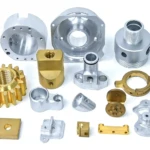17-4PH Stainless steel is a precipitation hardened martensitic stainless steel commonly used in applications requiring high strength and moderate corrosion resistance. Is a high tensile strength material, the strength of this grade is the most commonly used stainless steel 304 And 316 twice. From the National Institute of Standards and Technology (NIST)the University of Wisconsin-Madison and Argonne National Laboratory have identified 17-4 Composition of steel, a new discovery could help 17-4PH Parts Manufacturer Pass3D Print to reduce costs and increase manufacturing flexibility.

stainless steel3D printed 17-4 Microscopic image of stainless steel, photomicrograph showing 3D Printing of elongated grains inside the stainless steelThe colors on the left side of the image represent the different orientations of the crystals in the alloy.© University of Wisconsin–Madison
Ingredient ratio changes print results
3DMetal printing is particularly complex, in part because temperatures change so quickly during the process. Despite the advantages over traditional manufacturing, certain ingredient ratios3DPrinting may produce inconsistent results.
FBPMetal additive manufacturing essentially uses high-power sources such as lasers to “weld” millions of tiny particles of metal powder into a whole, by melting the metal powder into a liquid and then cooling it to form a solid , according toNISTScientist Zhang Fan, metal3DThe print cools at very high rates, sometimes exceeding a million degrees Celsius per second, and these extreme non-equilibrium conditions present an extraordinary set of measurement challenges.
according toNISTScientist Zhang Fan said that because the material heats and cools so quickly, the arrangement of atoms or crystal structure inside the material changes quickly, making it difficult to determine. Without understanding3DWhat happens to the crystal structure of printed steel is what researchers have been trying to do for years3D Print17-4PHFor stainless steel, the crystal structure of the printed result must be perfect – a material called martensite – in order to exhibit its highly sought-after material properties.

© 3DScience Valley White Paper
XDROverview of the printing process
So, what happens during rapid temperature changes?
In order to find a way to obtain martensite3DTo print the results, researchers use the synchrotron X Ray diffraction (or XRD) to observe rapid structural changes occurring within milliseconds.
passX Ray diffraction (XRD) Observing rapid structural changes that occur within milliseconds is a fundamental technique in materials science and engineering, providing information about well-defined structures, such as crystal lattices or interfaces in multilayer materials.
According to Professor Chen of mechanical engineering at the University of Wisconsin-Madison, in XRD During the process,X When the rays interact with the material, they create a signal, like a fingerprint, that matches the specific crystal structure of the material.
The team mapped the crystal structure in3DChanges during the printing process reveal how certain factors they control, such as the composition of the metal powder, affect the overall process.
Although iron is 17-4PH Steel is the main component, but the composition of alloys can contain varying amounts of up to a dozen different chemical elements. Researchers now have a clear idea3DUsing images of structural dynamics during the printing process as a guide, we were able to refine the composition of the steel, finding a set that included only iron, nickel, copper, niobium, and chromium.
Ingredient control is indeed3DThe key to printing alloys, by controlling the composition, can control3DHow the printing process is cured. The researchers also showed that over a wide range of cooling rates, such as 1,000 arrive 1000 Between 10,000 degrees Celsius and 10,000 degrees Celsius, the composition can still produce a complete martensite 17-4PH steel.
This new research could also lead to 17-4PH caused a sensation in the steel sector and relies on XRD The method can also be used to optimize other alloys for more predictable results.3D printing, in particularXRD The revealed information can be used to build and test systems designed to predict3DQuality computer models of printed parts.
Source: 3D Science Valley
Daguang focuses on providing solutions such as precision CNC machining services (3-axis, 4-axis, 5-axis machining), CNC milling, 3D printing and rapid prototyping services.

















